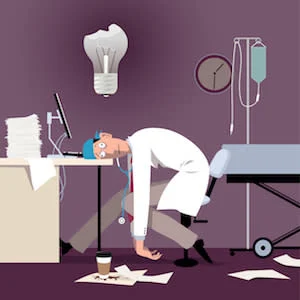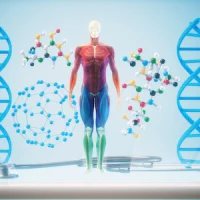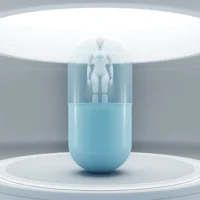The increased use of new evolving technologies and CT and MR expects the average radiologist to interpret an image every 3 to 4 seconds to stay on top of workflow demands. This workload piles on top of other responsibilities expected from radiologists like business administration, training and mentoring and conducting research. In a report published in the Journal of the American College of Radiology, the objective is to shift from looking at established burnout to understanding and developing resilience.
The sturdy poses the question "How did you go from loving radiology to despair?"
Burnout has been published on extensively and the authors declare they would not address the topic by staring at the problem. Rather, the objective of the report is to help radiologists understand resilience, a practical and useful concept.
You may also like: Dealing with radiologists burnout
The Merriam-Webster dictionary defines resilience as “an ability to recover from or adjust easily to misfortune or change”. However, the report suggests, resilience can also be thought of as pushing and moving through. Typical for most radiologists—long days, increasing workload, and constant interruptions. Although resilience is not the complete answer, resilience empowers one to take control rather than be reduced to a passive recipient.
The actions to decrease burnout are well known. But, how do we develop resilience? The Robertson Cooper model for building resilience has four general components:
1. adaptability
2. purposefulness
3. confidence
4. social support
Several components overlap and the report reviews certain ideas to build resilience that can be implemented in a radiology practice.
1. Adaptability
Compartmentalise Cognitive Load
Multitasking has been proven to be inefficient. Ratwani et al demonstrated that a radiologist, on average, is interrupted every 12.1 min. On-call radiologists may experience interruptions up to every 4 min, which is nearly 2 hours’ worth of interruptions per 12-hour shift. Moreover, reorienting back to your original task takes up to 23 min. Solutions include having a reading room assistant filter phone calls and having specific time blocks where consultations and determinations of protocol are performed.
Detachment Breaks
The Pomodoro technique is well known in the business sector; tasks are broken up into 25-min segments, and a short break is taken after each. The idea is that mental focus, clarity, and energy cycles are typically 90 to 120 min long, so it is useful to step away from our work for a few minutes to reset energy and attention. These breaks can be in the form of a short walk, a bathroom break, or getting a snack.
Respond Rather Than React
De-centring stress enables the core resilience skill of “response flexibility,” which is the ability to pause, reflect, and shift perspectives to create options, which helps us respond rather than react. This becomes significantly easier when we put situations into context and understand that certain interruptions are necessary, such as clarifying questions to provide better patient care. The objective is not to suppress or eliminate feelings of annoyance or anger but instead to acknowledge the emotions and redirect the train of thought. This can be difficult but gets easier with practice.
Compassion
Compassion increases positive emotions, cooperation, and collaboration, which can decrease stress and improve work culture. Compassion for patients comes easily for doctors, but compassion for self and those we work with may be harder. It can be difficult for type A people to practice self-compassion because they can be more self-critical. .
2. Purposefulness
Inspiration
Refocus periodically on why you chose to pursue medicine as a career. It is imperative to create both short-term and long-term goals, not just for yourself but also for your section and department. Recognise and reward progress toward these goals. Empower those who inspire, and be inspiring yourself. Have a strong culture of mentorship and team spirit.
Understanding Your Role
In radiology, sometimes it is easy to forget that each scan is a patient seeking care. The report states, "We are doctors, and we need to take care of these “films” and treat them like patients." This may be one of the hardest tasks to accomplish unless you consciously remind yourself.
Noting Good Contributions
In life, in medicine, and no doubt in radiology, negativity often drowns out any positive contributions or accomplishments, highlights the report. Praise and gratitude may seem trivial, but acknowledgement not only reminds us of our role and purpose, it also enhances our confidence. Positive feedback may not be given often, so take it upon yourself to note at least one thing from your day and year that you are proud of. Generating internal positive feedback will keep you motivated, build your confidence, and reduce the need for external validation. By the same token, provide positive feedback to others who have made good contributions.
3. Confidence—Personal and Professional
Confidence in one’s abilities, positivity, and a strong sense of self-worth fuel psychological resilience to stressful events. Conversely, negativity has been found to do the opposite. The breadth of medicine makes it impossible to know everything. The work environment should be structured to maximise individual functioning and confidence. Individual confidence is intimately related to the work environment. A timid person can become confident in a supportive work place, whereas a confident person can become less confident in an environment filled with harassment and discrimination.
How can we ask for help from our colleagues when they are drowning in work themselves? This is a very complex issue, and there are limited things an individual can do. Fostering teamwork, valuing honesty, and creating a culture that rewards group success rather than individual productivity are key in the workplace and encourage seeking help from peers when necessary.
4. Social Support
The report describes social support is an individual’s perception of support presence in any situation and is important in the formation of resilience; it has been associated with better outcomes when faced with stressors, and it encourages adaptive coping strategies. Support can come from family, friends, or colleagues and extends beyond the reading room. Internalising negative thoughts may at times be easier than discussing them; however, a more objective view on our thoughts often aids in disentangling seemingly similar emotions and distilling them to key points that can more easily be addressed.
Practicing individual resilience is not a remedy, according to the study; however, this does not mean that it is not important. Often individual resilience is touted as a potential fix for a bad work environment. It is impossible for an individual to “meditate” out of burnout symptoms! Furtheremore, the report states that radiologists must recognise that every workplace has room for improvement. There should be equal emphasis on external factors, such as workplace design and culture, and on building personal resilience.
Image Credit: iStock
References:
1
R. McDonald, K. Schwartz, L. Eckel, et al.
The effects of changes in utilization and technological advancements of cross-sectional imaging on radiologist workload
Acad Radiol, 22 (2015), pp. 1191-1198
ArticleDownload PDFView Record in ScopusGoogle Scholar
2
Merriam-Webster Dictionary. Resilience. Available at: https://www.merriam-webster.com/dictionary/resilience. Accessed August 22, 2017.
Google Scholar
3
E. Greitens
Resilience: hard-won wisdom for living a better life
Houghton Mifflin Harcourt, New York, NY (2015)
Google Scholar
4
Robertson I, Cooper C. How non-psychologists build personal resilisence. Available at: https://www.robertsoncooper.com/blog/how-non-psychologists-build-personal-resilience-1/. Accessed August 20, 2017.
Google Scholar
5
American Psychological Association
Multitasking: switching costs
Available at:
http://www.apa.org/research/action/multitask.aspx, Accessed 20th Aug 2017
Google Scholar
6
R.M. Ratwani, E. Wang, A. Fong, C.J. Cooper
A human factors approach to understanding the types and sources of interruptions in radiology reading rooms
J Am Coll Radiol, 13 (2016), pp. 1102-1105
ArticleDownload PDFView Record in ScopusGoogle Scholar
7
J.P. Yu, A.P. Kansagra, J. Mongan
The radiologist’s workflow environment: evaluation of disruptors and potential implications
J Am Coll Radiol, 11 (2014), pp. 589-593
ArticleDownload PDFView Record in ScopusGoogle Scholar
8
J. Robinson
Too many interruptions at work?
Available at:
http://www.gallup.com/businessjournal/23146/too-many-interruptions-work.aspx/, Accessed 22nd Aug 2017
Google Scholar
9
F. Cirillo
The Pomodoro technique
Available at:
http://baomee.info/pdf/technique/1.pdf, Accessed 22nd Aug 2017
Google Scholar
10
N. Kleitman
Basic rest-activity cycle—22 years later
Sleep, 5 (1982), pp. 311-317
CrossRefView Record in ScopusGoogle Scholar
11
Graham L. The neuroscience of integrating mindfulness and empathy to strengthen resilience. FACES Conference; October 19, 2012. Seattle, WA.
Google Scholar
12
M. Tugade, B. Fredrickson
Resilient individuals use positive emotions to bounce back from negative experiences
J Pers Soc Psychol, 86 (2004), pp. 320-333
CrossRefView Record in ScopusGoogle Scholar
13
Galanes P. Sheryl Sandberg and Elizabeth Alexander on love, loss and what comes next. Available at: https://www.nytimes.com/2017/05/13/fashion/sheryl-sandberg-and-elizabeth-alexander-on-love-loss-and-what-comes-next.html. Accessed August 22, 2017.
Google Scholar
14
M. Rutter
Psychosocial resilience and protective mechanisms
Am J Orthopsychiatry, 57 (1987), pp. 316-331
CrossRefView Record in ScopusGoogle Scholar
15
P. Resick
Clinical psychology: a modular course
Taylor & Francis Group, Philadelphia, PA (2001)
Google Scholar
16
C. Holahan, C. Holahan, R. Moos, P. Brennnan
Social support, coping, and depressive symptoms in a late-middle-aged sample of patients reporting cardiac illness
Health Psychol, 14 (1995), pp. 152-163
Latest Articles
Radiology, resilience, radiologist burnout
The increased use of new evolving technologies and CT and MR expects the average radiologist to interpret an image every 3 to 4 seconds to stay on top of workflow demands. This workload piles on top of other responsibilities expected from radiologists lik










